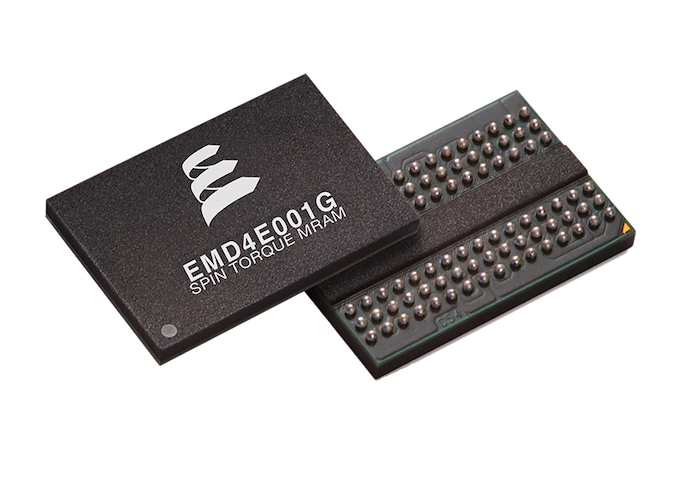Everspin Begins Production of 1Gb STT-MRAM
by Billy Tallis on June 24, 2019 4:30 PM EST- Posted in
- SSDs
- Storage
- GlobalFoundries
- Everspin
- MRAM

Everspin recently announced they have begun pilot production of their 1Gb STT-MRAM (Spin-transfer Torque Magnetoresistive RAM) nonvolatile memory, after shipping the first pre-production samples in December. The new MRAM parts are fabbed on a GlobalFoundries 28nm process and are a significant advance in density and capacity compared to their current 40nm 256Mb parts. Production will be ramping up through the second half of this year.
The new parts offer 8-bit or 16-bit DDR4 interfaces at 1333MT/s (667MHz), but as with the older DDR3-based MRAM components, timing differences mean they're not necessarily a drop-in replacement for DRAM. Low capacities have kept discrete MRAM components largely confined to embedded systems, where SoCs and ASICs can more easily be designed with compatible DDR controllers. The new 1Gb capacity will significantly broaden the appeal of MRAM, but Everspin still has a ways to go before catching up to the density of DRAM. We don't expect to see much in the way of MRAM-only storage devices yet (SSDs or NVDIMMs), but there will probably be more uses along the lines of the hybrid SSDs we've seen that still rely on NAND flash as the primary storage medium but replace some or all of the capacitor-backed DRAM with MRAM: IBM's FlashCore Module introduced last year, and a Seagate prototype shown at FMS 2017.
Everspin isn't the only company working on MRAM technology, but they are the the only supplier of discrete MRAM parts, as opposed to embedded on-die MRAM for ASICs. This is the second generation of discrete MRAM parts Everspin has produced in partnership with GlobalFoundries, and they also have embedded MRAM on the roadmap for GloFo's 22nm FD-SOI process. Since GlobalFoundries cancelled plans for 7nm and smaller processes, specialized processes including embedded memories like Everspin's MRAM have become crucial to their new future.
Source: Everspin










19 Comments
View All Comments
SaberKOG91 - Wednesday, June 26, 2019 - link
Given Microns involvement, I'm fairly certain 3D XPoint is PCM, yeah. Sorry, when I said performance, I was talking about throughput, latency, and power-efficiency. I didn't think I needed to address cost because it should be obvious that most new technologies are more expensive than mature ones. The Intel P4800X has 10us of latency, which is literally 100x better than the ~1-5ms of most FLASH devices and accomplished without a DRAM cache. I recognize that that is still about 1000x higher than DRAM latency, but it's a hell of a start for such a new technology.Threska - Monday, June 24, 2019 - link
The new Raspberry Pi could have used something like this.nandnandnand - Monday, June 24, 2019 - link
Is this the "no eMMC" complaint? The maximum microSD performance is doubled from the previous version, which should be good enough for most users.bill.rookard - Tuesday, June 25, 2019 - link
True enough, but something like this (non-volatile RAM) would add a level of reliability that SD cards don't have. Yes, they're 'good enough', but if we could have at least a SATA (port multiplier capable) interface for bulk storage I could see these becoming incredibly useful.Build your own NAS, build your own Smart TV, etc...
Santoval - Tuesday, June 25, 2019 - link
(STT-)MRAM is significantly faster than NAND flash, much faster even than Intel/Micron's 3D XPoint - though in the above example it is probably bottlenecked by the interface, which is both very narrow and low clocked.It is marginally slower than DRAM actually (at high densities) and even faster than DRAM - almost as fast as SRAM (at low densities), while its non volatility and very impressive power efficiency are surely worth the trade-off of somewhat lower performance at high density (or nodes from ~20nm and below, it's the same thing).
While 3D XPoint has a latency in the 3 - 15 microsecond range, (STT-)MRAM can have a latency from a blazing fast 2 ns up to ~200 ns, depending on the density.
Mr.Vegas - Sunday, June 30, 2019 - link
Like 3D Xpoint for example?.ksec - Tuesday, June 25, 2019 - link
Price. How much do they cost? This will fundamentally determine its usage.BMNify - Tuesday, June 25, 2019 - link
see the older parts specs prices etc assuming they will also sold herehttps://www.mouser.co.uk/Everspin-Technologies/fea...
ballsystemlord - Monday, July 1, 2019 - link
Will anandtech be doing an article explaining what MRAM is and how it works?! This is very exciting stuff and it looks like you might be able to do more than you did for Optane.PS: Wikipedia is unhelpful.